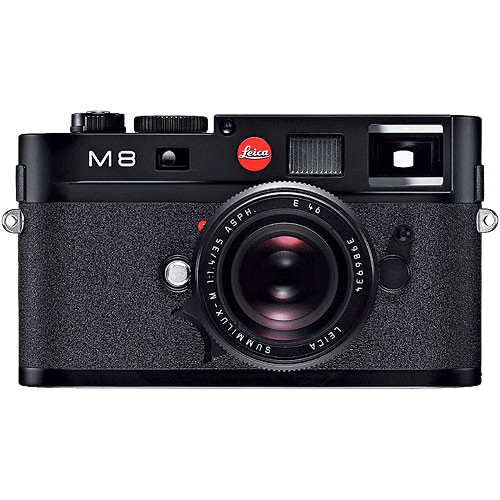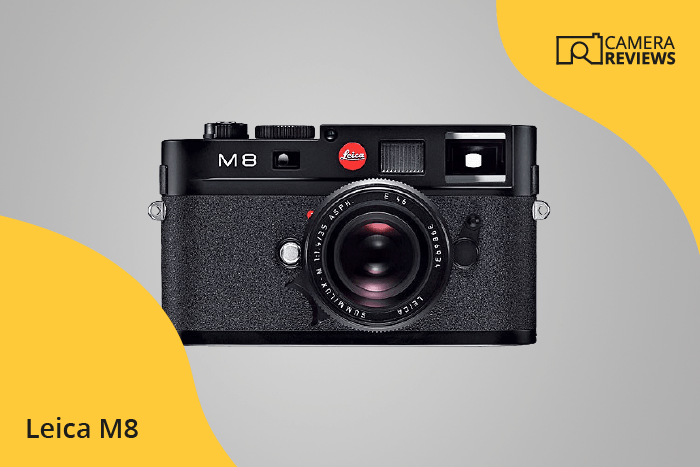Leica M8 Specs and Scores

The Leica M8 receives a score of 35/100 in our evaluation. Announced on September 14, 2006, and released the same year, this mirrorless camera comes with a hefty launch price of $5495. Measuring 139 x 80 x 37mm and weighing 591g or 1.30lbs, the M8’s specifications may not seem outstanding in today’s market, especially considering its age. However, it’s essential to delve into the camera’s optics to fully understand its capabilities and value.
Leica M8 Overview and Optics
The Leica M8 scores 43/100 in the optics category. Its 10.3-megapixel CCD sensor and Maestro II processor provide decent image quality. However, with a shooting speed of only 2 frames per second, it lags behind contemporary cameras. The camera’s DXOMARK sensor score of 59 reveals its limitations in today’s market.
The APS-H sensor size and Leica M lens mount offer compatibility with a wide range of lenses. However, the absence of image stabilization makes it less versatile in challenging shooting conditions. The 3:2 aspect ratio is a standard feature in most cameras, providing no unique advantage for the Leica M8.
The Leica M8’s optics are sufficient for casual photography, but they do not excel in the competitive camera market. Its specifications fall short when compared to modern cameras, making it less appealing to demanding photographers.
Leica M8 Video Performance
The Leica M8 lacks video capabilities. This camera focuses on photography and does not offer any video functions.
Leica M8 Features and Benefits
The Leica M8 receives a feature score of 17/100. This score reflects the camera’s limited capabilities when compared to modern cameras. The M8 has a 2.5-inch screen with a resolution of 230,000 dots. It lacks a touchscreen, flip screen, GPS, WIFI, and Bluetooth connectivity.
In today’s market, these specifications seem outdated. Many contemporary cameras offer larger screens with higher resolutions, touch capabilities, and various connectivity options. The absence of these features in the Leica M8 places it at a disadvantage for users seeking enhanced functionality and convenience.
Despite its lower feature score, the Leica M8 remains a classic camera for those who appreciate its distinct design and focus on manual controls. However, for users seeking advanced features and connectivity, there are more suitable options available.
Leica M8 Storage and Battery
The Leica M8 scores 29/100 in storage and battery. It has one memory card slot accepting SD and SDHC cards. The battery life lasts for 550 shots, using a BP-SCL1 battery type. Unfortunately, it does not support USB charging.
Compared to current market standards, the Leica M8 falls short in battery performance and storage options. Contemporary cameras often provide multiple memory card slots and support for higher-capacity cards. Additionally, USB charging has become a standard feature in many models.
The Leica M8’s storage and battery specifications reveal its limitations in these areas. With advancements in technology, modern cameras offer superior performance in these aspects.
Leica M8 Alternatives
Do you want to know how the Leica M8 compares to its competitors? Have a look at the most popular comparisons for this camera below:
- Fujifilm X-T5 vs Leica M8
- Leica M8 vs Olympus OM System OM-1
- Canon EOS Rebel T2i / 550D vs Leica M8
- Canon EOS Rebel T7i / 800D vs Leica M8
- Leica M8 vs Nikon Z50
- Canon EOS R7 vs Leica M8
Leica M8 FAQ
Does the Leica M8 Have Built-in Image Stabilization?
The Leica M8 does not have built-in image stabilization. Users will need to rely on their shooting technique and potentially use a tripod for stable shots.
Does the Leica M8 Support 4K Video Recording?
The Leica M8 does not support 4K video recording as it lacks any video functionality. It is primarily designed for still photography.
What Size Sensor Does The Leica M8 Have?
The Leica M8 is equipped with an APS-H sized sensor, which is slightly larger than APS-C but smaller than full-frame sensors.
Does the Leica M8 Have a Dual Memory Card Slot?
The Leica M8 does not have a dual memory card slot. It only features a single SD card slot for storage.
Does the Leica M8 Have a Touch Screen?
The Leica M8 does not have a touch screen. Navigation and settings adjustments are done through physical buttons and dials on the camera body.
Does the Leica M8 Have Wi-Fi and Bluetooth?
The Leica M8 does not have Wi-Fi or Bluetooth connectivity. Transferring images requires the use of an SD card reader or connecting the camera via USB.
Does the Leica M8 Have GPS?
The Leica M8 does not have built-in GPS functionality. Geotagging images would require the use of an external GPS device and post-processing software.
Is the Leica M8 Weather Sealed?
The Leica M8 is not weather sealed, so extra care should be taken when using it in adverse weather conditions or environments with dust and moisture.
Does the Leica M8 Have a Built-in Flash?
The Leica M8 does not have a built-in flash. Users will need to use an external flash or other light sources for low light photography.

